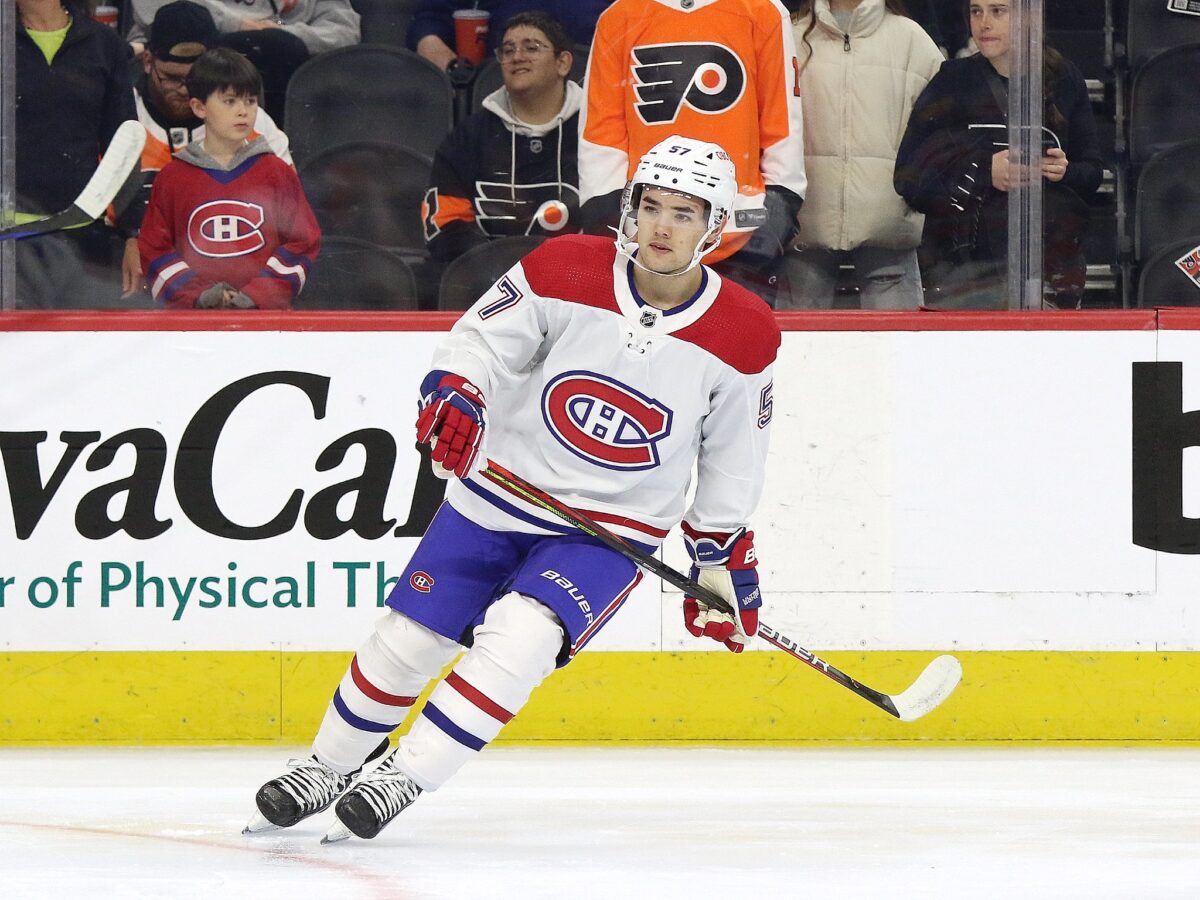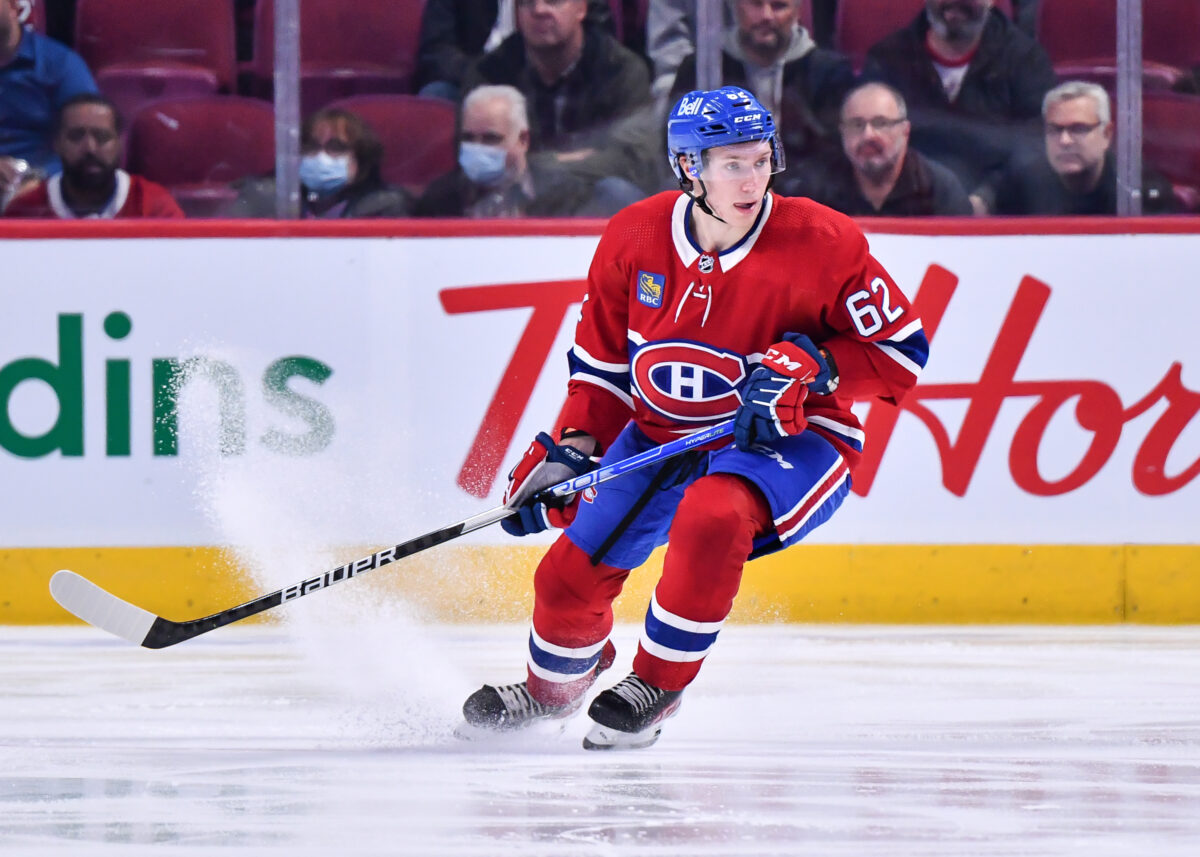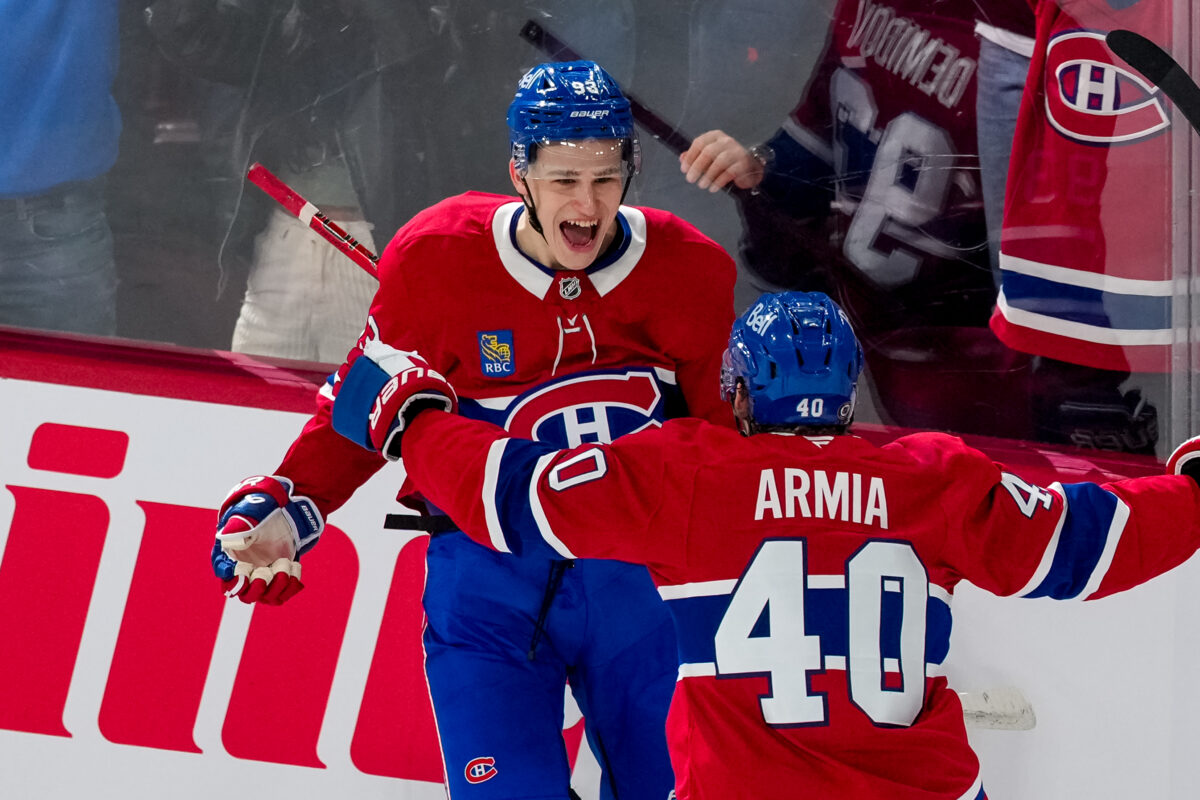With the dust now settled on the 2025 NHL Entry Draft and the World Junior Summer Showcase, the spotlight turns to training camp, and the Montreal Canadiens head into it with one of the deepest and most exciting prospect pipelines in the NHL.
The Habs’ pool isn’t just about high-end prospects like Ivan Demidov or David Reinbacher. It’s also rich in variety, featuring a mix of offensive flair, responsible two-way players, shutdown defenders, and intriguing goaltenders. Several of these players made strong impressions at the Summer Showcase, while others continue to develop in the NCAA, Canadian Hockey League (CHL), American Hockey League (AHL), or overseas.
This ranking includes only players who have not yet played a full season in the NHL. That excludes young players like Juraj Slafkovsky, Kaiden Guhle, and Lane Hutson, but includes many who are on the cusp of breaking through. The result is a list of 25 names who, if developed properly, could be key pieces of Montreal’s long-term success.
25. Sam Harris – LW
Sam Harris is a hardworking winger who plays with structure and consistency. He doesn’t have elite tools, but he excels at doing the little things that win games. While he is a long shot to make the NHL, his attitude and work ethic could earn him a look as a depth call-up down the line.
24. Arseni Radkov – G
Arseni Radkov is a recent addition to the Canadiens’ European pipeline and brings intriguing size for a goaltender. Standing at 6-foot-4, he is big, takes space and is often well-positioned. He will be playing for the Boisbriand Armada this season, and fans will have the opportunity to see more of him as he will play closer to Montreal.
23. Sean Farrell – LW
Sean Farrell has slipped down the rankings, but he still possesses impressive offensive instincts. His vision and passing touch are top-tier, and when given space, he can orchestrate plays with ease. At his best, he’s a cerebral forward who knows how to create chances for teammates.

The challenge for Farrell has been his small size. His smaller frame makes it harder to battle for space, and he’ll need to improve his strength and compete level to earn another shot in the NHL.
22. Carlos Handel – RD
Carlos Handel is a big two-way defenseman who plays with effort and intelligence. He’s responsible in his own zone, and while not flashy, he contributes by doing the little things right. Handel’s NHL upside is limited, but his strong work habits make him a potential depth call-up option in the future.
21. Makar Khanin – RW
Makar Khanin is a smart, high-IQ offensive forward. The Russian played only a handful of games last season for Moscow Dynamo, but should have more time in the KHL this season. Montreal sees Khanin as a long-term project. He may not be the fastest, but he understands the game very well.
20. Jared Davidson – C
Jared Davidson is built on structure, and he plays a coachable style that makes him an ideal support piece. He rarely takes unnecessary risks and helps drive possession by winning battles along the walls. He projects as a bottom-six center who could eventually earn NHL time due to his reliability.
19. Luke Tuch – LW
The younger brother of Buffalo’s Alex Tuch, Luke is a big-bodied winger who plays a power-forward style. He’s most effective when he simplifies his game, driving to the net, finishing checks, and grinding out possession. While he hasn’t developed as quickly as hoped, he’s become a reliable AHL contributor.
18. Bryce Pickford – RD
Bryce Pickford is an offensive defenceman who plays with intelligence and consistency. His offensive tools are what stand out. He scored 20 goals in 48 games last season for the Medicine Hat Tigers as a defenceman. He projects as a project, possibly a power-play specialist at the next level.
17. Tyler Thorpe – RW
Tyler Thorpe was one of the surprises of Canadiens training camp last year, sticking around longer than most expected. He’s a strong skater with a non-stop motor and plays a fearless style that endears him to coaches. Thorpe thrives on the forecheck and has a knack for creating chaos in the offensive zone.
Though he doesn’t have elite skill, Thorpe makes up for it with energy and willingness to do the dirty work. His upside may be limited, but he could very well become a fourth-liner who brings grit, physicality, and smart positional play. He’s the type of underdog fans love to root for.
16. Owen Protz – LD
Owen Protz is a throwback-style defenceman who thrives on physical play and defensive responsibility. He’s not going to lead the rush or run a power play, but he takes pride in shutting down opponents and blocking shots. At 6-foot-2, he uses his size effectively, especially in front of the net and along the boards.
Though limited offensively, Protz has shown he can make safe, quick outlet passes and doesn’t panic under pressure. His path to the NHL likely runs through the AHL, where he’ll need to prove he can keep up with the pace of pro hockey. If he does, he has the potential to be a bottom-pairing defenseman.
15. Bogdan Konyushkov – RD
Bogdan Konyushkov is a seasoned KHL defenseman with a calm, mature game. He isn’t flashy, but he makes the right play consistently and excels at moving the puck out of danger. His ability to handle a heavy workload against pro competition makes him one of Montreal’s more NHL-ready international prospects.
The question with Konyushkov is whether his game can translate to the smaller ice. His skating and quick decision-making will be tested if he comes to North America, but his high hockey IQ gives him a solid chance. At 22, he’s not a long-term project, but if he comes over and performs well in Laval, he could be in the NHL mix at some point.
14. Vinzenz Rohrer – RW
Vinzenz Rohrer is a high-motor winger who plays much bigger than his frame. His speed and tenacity make him a relentless forechecker, and his agility helps him win puck battles against larger opponents. Rohrer is the type of player who frustrates defenders by never taking a shift off. He also has decent puck skills and has shown flashes of offensive upside, particularly when driving the net.
While Rohrer’s offensive production hasn’t always matched his effort, there’s reason to believe he could carve out a role in the NHL. His experience at the World Championship helped showcase his versatility and maturity. If he can continue to grow offensively and fill out his frame, he may become an ideal third-line energy winger in the future.
13. Florian Xhekaj – LW
Like his brother Arber, Florian Xhekaj plays with an edge and isn’t afraid to throw his weight around. The younger Xhekaj had a strong rookie season in Laval, showing that his game extends beyond toughness. He battles hard in corners, protects the puck well, and has developed into a reliable forechecker with a surprising amount of offensive instinct.
Though he may never be a major point producer, Xhekaj’s physicality, work ethic, and improving skating make him a candidate for a fourth-line NHL role. He brings the kind of energy coaches love, and he’s not afraid to stand up for teammates. If he continues to develop his offensive timing and positioning, he could find a niche as a physical depth winger with staying power.
12. LJ Mooney – C
One of the most dynamic forwards in the 2025 Draft class, LJ Mooney is all about speed, hands, and creativity. He can beat defenders one-on-one with ease and thrives in open ice where his quickness and edgework allow him to generate space. Mooney also has a dangerous shot and can score from distance, making him a potential future power-play weapon. His ceiling is one of the highest among Montreal’s forward prospects.
That said, Mooney still needs to round out his game. His size (5-foot-7) and defensive reliability are concerns, and he’ll need to bulk up and adjust to the physicality of pro hockey. If he’s given time to develop, he could blossom into a top-six offensive threat. The Canadiens took a calculated gamble on him, and the early returns are promising.
11. Hayden Paupanekis – C
Hayden Paupanekis was a third-round pick in the 2025 Draft and has quickly generated buzz thanks to his rare mix of size, skating, and raw upside. At 6-foot-4, he already has an NHL frame and uses it effectively. While his offensive game is still developing, he’s shown flashes of confidence with the puck, particularly in transition. His long reach and physicality give him the tools to become a solid centre.
Defensively, Paupanekis is already ahead of the curve. He reads plays well for his age, and his gap control has improved steadily over the past season. His skating, while not elite, is solid enough for a player his size, and with more reps, he could become a penalty-kill specialist.
10. Aatos Koivu – C
Aatos Koivu, son of former Habs captain Saku Koivu, has emerged as one of the most exciting prospects in the organization. He dominated the Summer Showcase with six goals and one assist in five games, leading all players in goals. Koivu’s offensive instincts, combined with his smooth skating and soft hands, make him a constant threat. He also plays with the intelligence and work ethic reminiscent of his father, making him a fan favourite in waiting.
Related: Canadiens Prospect Aatos Koivu Opened Eyes at the World Junior Summer Showcase
What’s remarkable is Koivu’s resilience. After missing the 2024 World Juniors due to mononucleosis, he’s bounced back stronger than ever. He’s expected to be a key player for Finland at the upcoming tournament, and his stock continues to rise. A third-round pick in 2024, Koivu could prove to be one of Montreal’s biggest steals of the past few drafts.
9. Joshua Roy – RW
Joshua Roy has developed into a well-rounded offensive winger with high hockey IQ. He has a knack for finding soft spots in defensive coverage and capitalizing on scoring chances. Roy’s playmaking ability and improved shot make him a dual threat in the offensive zone. In the AHL, he has shown he can adapt to the pace of professional hockey while maintaining his scoring touch.
8. Adam Engström – LD
Adam Engström is a smooth-skating Swedish defenceman with excellent puck-moving skills. He thrives under pressure, using his skating to evade forecheckers and transition play effectively. His offensive instincts allow him to join the rush and create opportunities, while his strong positional play helps him hold the defensive zone. His vision and passing are among the best in Montreal’s defensive pipeline.
The departure of Logan Mailloux has opened the door for Engström to take on a bigger role in Laval. His combination of mobility and decision-making makes him one of the most promising blueliners in the organization.
7. Oliver Kapanen – C
Oliver Kapanen brings speed and grit to Montreal’s prospect pool. He’s a relentless forechecker who thrives on pressuring puck carriers and forcing turnovers. Kapanen’s north-south game is built for bottom-six roles, and his ability to contribute offensively through net-front battles and quick plays around the crease gives him a chance to stick in the NHL.
While Kapanen may not have the offensive upside of others on this list, his versatility and work ethic make him a valuable depth option. Coaches love players like him because he can play on the penalty kill, handle tough defensive matchups, and bring energy shifts when needed. If he continues developing his finishing ability, he could carve out a long NHL career.
6. Owen Beck – C
Owen Beck is the prototypical two-way centre every NHL team covets. Known for his hockey sense, he reads plays quickly and anticipates puck movement, which allows him to excel both offensively and defensively. Beck’s faceoff prowess and ability to kill penalties add even more value to his profile. He has the tools to be a versatile middle-six centre capable of taking tough defensive assignments.

Offensively, Beck has made strides since being drafted, showing more confidence driving play and attacking high-danger areas. His shot release has improved, and he’s starting to use his strong skating to push defenders back. While his ceiling might not be as high as some of Montreal’s flashier prospects, his reliable all-around game suggests he will be an NHL regular in the near future.
5. Alexander Zarhovsky – RW
Alexander Zarhovsky, drafted in 2025, is the definition of a high-upside swing. A creative and crafty winger, he possesses elite puck skills and an offensive mind that thrives on improvisation. He is the type of player who can change a game with a single dazzling play, using a good wrist shot and deceptive release to beat goalies from various angles.
However, Zarhovsky is still a work in progress. His defensive play and off-puck positioning require refinement, and he needs to add muscle to handle the rigours of professional hockey. With time and proper development, he could blossom into a top-six scoring winger. The Canadiens believe his offensive ceiling is worth the wait, making him one of the most intriguing names in their pipeline.
4. Jacob Fowler – G
Jacob Fowler’s steady rise has been one of the most pleasant surprises for Canadiens fans. After an outstanding freshman season at Boston College, he established himself as a reliable and mentally tough goaltender. Fowler’s game is built on positioning and composure; he rarely overcommits, tracking pucks with calm precision. His rebound control has improved significantly, making him one of the top goaltending prospects in the NHL.
What sets Fowler apart is his ability to perform under pressure. Whether it’s a late-game surge or a playoff scenario, he thrives in high-stakes moments. His mental fortitude, combined with his growing technical mastery, has many projecting him as a future NHL starter. Montreal has long searched for a successor to Carey Price, and Fowler’s development is a major reason for optimism.
3. Michael Hage – C
Michael Hage, the Canadiens’ first-round pick in 2024, has quickly become one of the system’s most exciting young centers. He has the skating ability and playmaking skills to drive a line, excelling both at carrying the puck and setting up teammates. His ability to find open ice and exploit defensive gaps makes him a constant threat in the offensive zone. At the Summer Showcase, he impressed with Team Canada, showing poise under pressure and the ability to create offence against elite competition.
Hage’s competitive drive allows him to win puck battles despite not being the biggest player on the ice. As he transitioned to NCAA hockey, he rounded out his game. With his blend of skill, hockey IQ, and work ethic, he has all the makings of a second-line centre who can thrive in key moments.
2. David Reinbacher – RD
Selected fifth overall in 2023, Reinbacher is a defenseman built for modern hockey. At 6-foot-3 with excellent mobility, he combines strong gap control with smart, accurate passes that fuel clean transitions. He has dealt with multiple injuries these last few years, but a healthy season could see him in contention to get some games in Montreal.
Reinbacher is not an offensive dynamo, but his poise with the puck and ability to calmly exit the defensive zone under pressure stand out. His hockey sense allows him to read plays early and neutralize top forwards, making him a steady presence on the back end.
1. Ivan Demidov – RW
Demidov is Montreal’s crown jewel prospect, and for good reason. Drafted fifth overall in 2024, the Russian winger possesses an explosive combination of puck skills, vision, and creativity that makes him a nightmare for opposing defenders. His hands are silky and deceptive, capable of pulling off highlight-reel moves in high-pressure situations. Even in limited ice time with SKA St. Petersburg in the Kontinental Hockey League (KHL), Demidov found ways to produce and impact games, showcasing an offensive toolkit that’s already near NHL-ready. He thrives on making quick decisions and sees passing lanes that most players simply can’t.

Demidov’s value goes beyond raw skill. While his defensive game is still developing, his high hockey IQ suggests it won’t take long for him to become reliable in all three zones. With his mix of skill and drive, the Canadiens believe they have a legitimate franchise-altering talent on their hands.
Montreal’s future is in excellent hands. With blue-chip talents like Demidov, Reinbacher, and Hage leading the way, complemented by a steady flow of NHL-ready depth, the Canadiens have arguably their strongest pipeline in decades. What’s most encouraging is the variety: high-end forwards, reliable defencemen, developing goaltenders, and a blend of European, North American, and NCAA routes.
Not every name on this list will make it; that’s the nature of development. But with such a deep and well-scouted group, the odds are in Montreal’s favour.
